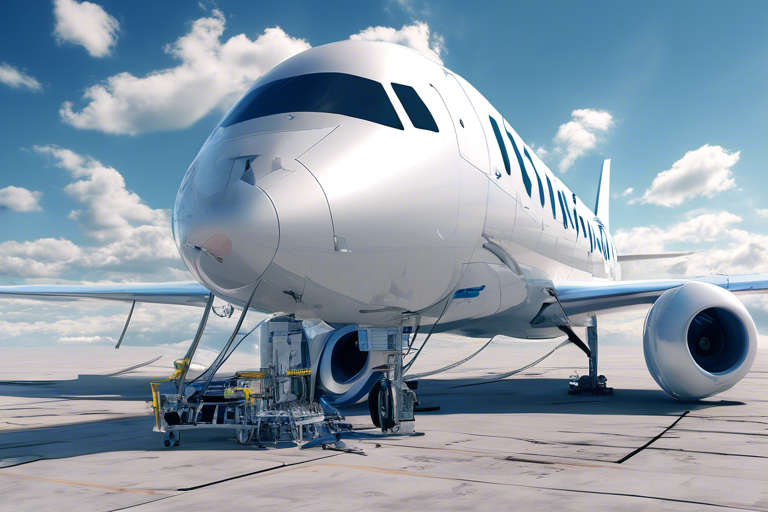
Unlocking the Potential of Aviation Safety: How Aircraft Health and Usage Monitoring Systems (HUMS) are Revolutionizing the Industry
Introduction to Aircraft Health and Usage Monitoring Systems (HUMS)
The aviation industry has always prioritized safety, and advancements in technology have played a significant role in improving aircraft safety measures. One such technological marvel is the Aircraft Health and Usage Monitoring Systems (HUMS). HUMS technology has revolutionized the industry by providing proactive monitoring and maintenance capabilities, ensuring the highest level of safety for both passengers and crew.
Access our popular detailed report here:
https://www.marketsandmarkets.com/Market-Reports/aircraft-health-monitoring-systems-market-954.html
The role of HUMS in aviation safety
Traditionally, aircraft maintenance has been reactive, with inspections and repairs conducted at regular intervals or in response to reported issues. However, HUMS technology has shifted the paradigm by enabling real-time monitoring of critical components and systems. By continuously collecting data on various parameters like vibration, temperature, and usage, HUMS can identify potential faults and alert maintenance crews even before an actual problem occurs. This proactive approach allows for timely and preventive maintenance, significantly reducing the risk of in-flight failures and enhancing overall aviation safety.
Download PDF Brochure @
https://www.marketsandmarkets.com/pdfdownloadNew.asp?id=954
Benefits of implementing HUMS technology
Implementing HUMS technology brings numerous benefits to the aviation industry. Firstly, it enhances safety by providing early warning signs of potential failures, allowing for timely maintenance actions. This proactive approach not only minimizes the risk of accidents but also reduces unscheduled maintenance, leading to improved aircraft availability and operational efficiency. Moreover, HUMS technology optimizes maintenance practices by enabling condition-based maintenance, wherein components are serviced based on their actual health status rather than fixed time intervals. This approach reduces unnecessary maintenance activities, saving time and costs while ensuring optimal performance.
Additionally, HUMS technology enhances data-driven decision-making by providing valuable insights into the health and performance of aircraft systems. By analyzing the vast amount of data collected by HUMS, aviation professionals can identify patterns, trends, and potential areas of improvement. This data-driven approach not only aids in optimizing maintenance practices but also contributes to the continuous improvement of aircraft design, leading to safer and more efficient aircraft in the future.
Evolution of Aircraft Maintenance: From reactive to proactive
The evolution of aircraft maintenance from a reactive to a proactive approach has been instrumental in improving aviation safety. In the past, maintenance activities were primarily conducted based on fixed time intervals or in response to reported issues. However, this approach had limitations as it did not account for the actual condition of the aircraft components. With the advent of HUMS technology, the industry witnessed a paradigm shift towards condition-based maintenance. By continuously monitoring critical parameters, HUMS enables maintenance crews to focus on components that require attention based on their actual health status. This approach not only minimizes the risk of failures but also optimizes maintenance practices, resulting in increased safety and operational efficiency.
How HUMS technology works?

Aircraft Health and Usage Monitoring Systems (HUMS) utilize a combination of sensors, data acquisition units, and advanced analytics to monitor the health and performance of critical aircraft components. The system collects data on various parameters, such as vibration, temperature, and usage, from sensors strategically placed throughout the aircraft. This data is then transmitted to a central processing unit, where it undergoes extensive analysis using advanced algorithms.
The analysis involves comparing the collected data with predefined thresholds and patterns to identify any abnormalities or potential faults. If an anomaly is detected, the system generates an alert, allowing maintenance crews to take proactive measures. Additionally, the data collected by HUMS is stored and can be further analyzed to identify trends, predict failures, and optimize maintenance practices. This comprehensive approach ensures that aircraft systems are continuously monitored, and any potential issues are addressed before they escalate into critical failures.
Key components of Aircraft Health and Usage Monitoring Systems
Aircraft Health and Usage Monitoring Systems (HUMS) consist of several key components that work together to ensure comprehensive monitoring and maintenance capabilities. These components include:
1. Sensors: Sensors are strategically placed throughout the aircraft to collect data on various parameters like vibration, temperature, and usage. These sensors act as the eyes and ears of the HUMS system, continuously monitoring the health and performance of critical components.
2. Data Acquisition Units: Data acquisition units are responsible for collecting and transmitting the data collected by the sensors to a central processing unit. These units ensure that the data is accurately captured and securely transmitted for further analysis.
3. Central Processing Unit: The central processing unit is the heart of the HUMS system. It receives the data from the data acquisition units and applies advanced analytics and algorithms to analyze the data. The central processing unit compares the collected data with predefined thresholds and patterns to detect anomalies and generate alerts when necessary.
4. Data Storage and Analysis: The data collected by HUMS is stored for further analysis. This data can be analyzed to identify trends, patterns, and potential areas of improvement. The analysis of the data allows for continuous improvement in maintenance practices and provides valuable insights into the health and performance of aircraft systems.
Case studies: Successful implementation of HUMS in the aviation industry
The successful implementation of Aircraft Health and Usage Monitoring Systems (HUMS) has been demonstrated through various case studies in the aviation industry. One such case study involved a major airline that implemented HUMS technology on its fleet of aircraft. The airline experienced a significant reduction in unscheduled maintenance events, leading to improved aircraft availability and reduced operational costs. The proactive monitoring and maintenance capabilities provided by HUMS ensured that potential issues were identified and addressed before they resulted in critical failures.
Another case study focused on a military aviation unit that implemented HUMS technology on its helicopters. The implementation of HUMS resulted in a substantial reduction in maintenance downtime and increased operational readiness. The real-time monitoring provided by HUMS allowed maintenance crews to detect potential faults early and take proactive measures, ensuring the safety and reliability of the helicopters during critical missions.
These case studies highlight the effectiveness of HUMS technology in enhancing aviation safety and operational efficiency. The successful implementation of HUMS has not only improved the reliability of aircraft but also reduced maintenance costs and downtime, making it a valuable investment for the aviation industry.
Future trends in aircraft health monitoring systems
As technology continues to advance, the future of aircraft health monitoring systems holds promising possibilities. One of the key trends in this field is the integration of artificial intelligence (AI) and machine learning (ML) algorithms into HUMS technology. AI and ML algorithms can analyze vast amounts of data collected by HUMS and identify complex patterns and correlations that may not be apparent to human analysts. This advanced analysis can further enhance the predictive capabilities of HUMS, allowing for even more proactive maintenance actions and improved aviation safety.
Another future trend is the integration of HUMS with other aviation systems, such as flight data monitoring and predictive maintenance systems. By combining data from multiple sources, aviation professionals can gain a comprehensive view of the health and performance of aircraft systems. This integration will enable a more holistic approach to maintenance and safety, where data from various systems can be correlated and analyzed to identify potential risks and optimize maintenance practices.
Skywise Health Monitoring: A game-changer in aircraft health management
Skywise Health Monitoring is a game-changer in aircraft health management, offering a comprehensive and integrated solution for monitoring and maintaining aircraft systems. Developed by Airbus, Skywise Health Monitoring utilizes advanced analytics and machine learning algorithms to analyze data from various sources, including HUMS. This integrated approach allows for a more accurate and comprehensive assessment of the health and performance of aircraft systems.
Skywise Health Monitoring goes beyond traditional HUMS by incorporating data from flight data monitoring systems, maintenance records, and other sources. This comprehensive dataset enables aviation professionals to identify potential risks, predict failures, and optimize maintenance practices. The real-time monitoring and predictive capabilities of Skywise Health Monitoring empower maintenance crews to take proactive measures, ensuring the highest level of safety and reliability for aircraft.
80% of the Forbes Global 2000 B2B companies rely on MarketsandMarkets to identify growth opportunities in emerging technologies and use cases that will have a positive revenue impact.
- Leading Automated Guided Vehicle Companies 2024: An In-depth Analysis
- CHARGED UP: SHIFT TO E-MOBILITY AND THE EVOLUTION OF TRANSPORTATION
- Global Automotive Market: Predictions For 2024
- Revolutionizing Depot Charging: Hockey Stick Growth on the Cards
- The Mega Trends That Will Shape Our Future World
Aircraft Health Monitoring Systems Market
The global Aircraft Health Monitoring Systems market is projected to witness substantial growth in the coming years. The market size is estimated to reach USD 8.6 billion by 2028, with a CAGR of 6.5% from 2023 to 2028.
Major players operating in the Aircraft Health Monitoring Companies are Safran (France), Airbus S.E (Netherlands), Raytheon Technologies Corporation (US), Honeywell International Inc (US), Teledyne Technologies Inc (US), The Boeing Company (US), and Curtiss-Wright Corporation (US) among others.

Conclusion: The future of aviation safety with HUMS
Aircraft Health and Usage Monitoring Systems (HUMS) have revolutionized the aviation industry by shifting maintenance practices from reactive to proactive. The implementation of HUMS technology provides numerous benefits, including enhanced safety, optimized maintenance practices, and data-driven decision-making. By continuously monitoring critical components and systems, HUMS enables early detection of potential faults, resulting in timely maintenance actions and reduced risk of in-flight failures.
As technology continues to advance, the future of aircraft health monitoring systems holds immense potential. Integration with artificial intelligence and machine learning algorithms, as well as the incorporation of data from multiple aviation systems, will further enhance the capabilities of HUMS. Additionally, game-changing solutions like Skywise Health Monitoring offer comprehensive and integrated approaches to aircraft health management.
In conclusion, the implementation of HUMS technology and the continuous evolution of aircraft health monitoring systems are paving the way for a safer and more efficient aviation industry. By unlocking the potential of aviation safety, HUMS is reshaping the industry and ensuring that passengers and crew can fly with confidence.
Authored by Shweta Surender, MarketsandMarkets

